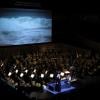
“No one ever asks me to cut a string quartet or a concerto,” John Adams complained to pianist Sarah Cahill. “I can’t get offstage after the premiere of one of my operas without hearing people muttering, ‘Cuts, cuts, cuts.’”
Their conversation took place on the Friday afternoon leading up to the premiere of Adams’s newly revised score for his Gold Rush opera, Girls of the Golden West. The performance featured Adams conducting the Los Angeles Philharmonic, a miners’ chorus of men from the Los Angeles Master Chorale, and a dream team of a cast with nearly all of the original members of the 2017 San Francisco Opera premiere. The Friday and Sunday concerts were recorded by Nonesuch Records.
Watching the intensity of the opening night performance, ending with Adams nearly collapsing in exhaustion, I was reminded of Captain Willard’s memorable line in Apocalypse Now: “I wanted a mission, and for my sins they gave me one.” Well, if Adams’s mission was to make Girls of the Golden West shorter and more dramatically forceful, he clearly succeeded.

The greatest advantage for this performance was having so many members of the original cast available. Their vocal stylings and familiarity with the roles provided bold intensity and heartfelt emotional resonance: Julia Bullock as the keen observer Dame Shirley; Davóne Tines as the freed slave Ned Peters; Paul Appleby as Joe Cannon, the miner with an incendiary temper; Hye Jung Lee as Ah Sing, the Chinese prostitute in search of “Gold Mountain”; Elliot Madore as Ramón, the Empire Hotel’s barman; and Ryan McKinny as Clarence King, the drama’s narrator. Of the original cast, only J’Nai Bridges was unavailable. Her crucial role as the ill-fated Josefa Segovia was sung (in English and impeccable Spanish) by Daniela Mack.
The concert performance placed the singers behind the orchestra (at podiums, on book). Beyond a multitude of meaningful stares and emphatic gestures, there was no attempt at staging. This placed the focus entirely on the music, which stood out in ways it never could from a pit. Adams’s conducting on opening night was pinpoint accurate and emotionally supercharged, as if all the months of pressure and expectation were finally being released. The reading was as explosive as it was relentless. By Sunday’s performance, with the pressure diminished, it seemed like Adams was able to relax a bit, which allowed the music and the drama the space it needed to breathe, creating more subtleties and contrast between the rambunctious spirit of the camp, with its ever-growing drunkenness and violence, and scenes that are imbued with sumptuous lyricism and serenity.
“I finally have a version I’m really happy with,” said Adams in conclusion.
When Girls of the Golden West premiered at SF Opera, the critical response was far from positive. There were, however, a few critics (including myself) who embraced the panoramic scope of the opera, its multiple musical vocabularies, and its fact-based libretto by Adams and Peter Sellars, relying heavily on historical narratives written by the people who lived them — most notably the detailed letters of life in the gold fields by Louise Clappe.

“We wanted to tell so much,” Adams recounts in the documentary film Land of Gold, which was screened on Saturday at REDCAT. “We wanted to tell the real story of the Gold Rush, about the people the textbooks in school left out.”
Audiences at the 2017 premiere complained the opera was too long (well over three hours), relied too much on narrative, and was “too talky.” At the same time, as directed by Sellars, it was undeniably stunning to watch and emotionally exhausting in its full-spectrum portrait of California history — heroism and adventure alongside greed, racism, and violence.
“When I was a young composer,” Adams related, “I was taught the audience doesn’t matter. All that matters is the work. I never bought into that. Verdi listened to his audiences and spent years on revising his operas. I had to admit my opera was too long and there was too much narrative. It needed to be shorter and more impactful.”
Adams’s first revised version was performed in 2019 in Amsterdam with a new powder-keg ending to Act 1. The current revised version, with more than 40 minutes of additional cuts, clocks in at a taut three hours with intermission. It is without question the experience Adams was seeking.

At the same time, there are lamentable losses. Gone is Dame Shirley’s painful encounter with a group of destitute Indian women. Gone is the flamboyant Fourth of July performance by Lola Montez of her notorious “Spider Dance” (a scene Sellars describes in the making-of documentary as “the hinge of the opera”). Gone is the wistful romantic duet between Josefa and Ramón that originally ended Act 1, representing the calm before the storm.
Is the new version better? If it wins audiences over, then it is, even if I don’t agree.




